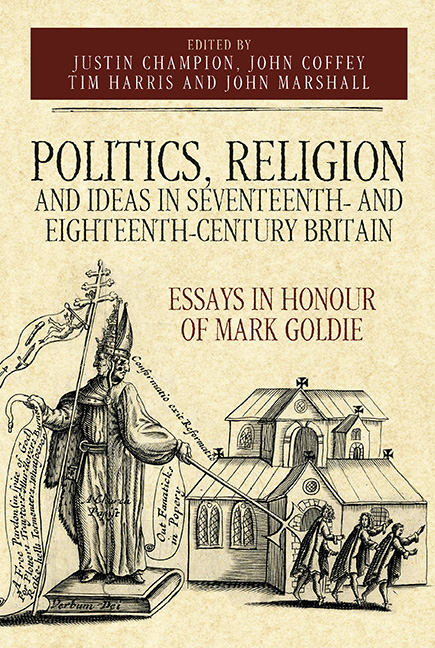 Politics, Religion and Ideas in Seventeenth- and Eighteenth-Century Britain
Politics, Religion and Ideas in Seventeenth- and Eighteenth-Century Britain Book contents
- Frontmatter
- Dedication
- Contents
- Notes on Contributors
- Acknowledgements
- Notes on Text
- Abbreviations
- Introduction: Mark Goldie – An Appreciation
- 1 Constitutional Royalism Reconsidered: Myth or Reality?
- 2 Teaching Political Thought in the Restoration Divinity Faculty: Avant-Garde Episcopacy, the Two Kingdoms and Christian Liberty
- 3 Violence, Protest and Resistance: Marvell and the Experience of Dissent after 1670
- 4 Bulstrode Whitelocke and the Limits of Puritan Politics in Restoration England
- 5 The Assassination of Archbishop Sharp: Religious Violence and Martyrdom in Restoration Scotland
- 6 Compassing Allegiance: Sir George Mackenzie and Restoration Scottish Royalism
- 7 Corruption and Regeneration in the Political Imagination of John Locke
- 8 Locke the Censor, Locke the Anti-Censor
- 9 London, Locke and 1690s Provisions for the Poor in Context: Beggars, Spinners and Slaves
- 10 The Reception of Locke's Politics: Locke in the République des Lettres
- 11 Court Culture and Godly Monarchy: Henry Purcell and Sir Charles Sedley's 1692 Birthday Ode for Mary II
- 12 Thanksgivings and the Signs of the Times: The Apocalypse in the Long Eighteenth Century
- 13 The ‘Secret Reformation‘ and the Origins of the Scottish Catholic Enlightenment
- 14 The Surprising Lineage of Useful Knowledge
- 15 The Vicissitudes of Innovation: Confessional Politics, the State and Philosophy in Early Modern England
- A Bibliography of the Writings of Mark Goldie
- Index
- Studies in Early Modern Cultural, Political and Social History
- Tabula Gratulatoria
5 - The Assassination of Archbishop Sharp: Religious Violence and Martyrdom in Restoration Scotland
Published online by Cambridge University Press: 12 October 2019
- Frontmatter
- Dedication
- Contents
- Notes on Contributors
- Acknowledgements
- Notes on Text
- Abbreviations
- Introduction: Mark Goldie – An Appreciation
- 1 Constitutional Royalism Reconsidered: Myth or Reality?
- 2 Teaching Political Thought in the Restoration Divinity Faculty: Avant-Garde Episcopacy, the Two Kingdoms and Christian Liberty
- 3 Violence, Protest and Resistance: Marvell and the Experience of Dissent after 1670
- 4 Bulstrode Whitelocke and the Limits of Puritan Politics in Restoration England
- 5 The Assassination of Archbishop Sharp: Religious Violence and Martyrdom in Restoration Scotland
- 6 Compassing Allegiance: Sir George Mackenzie and Restoration Scottish Royalism
- 7 Corruption and Regeneration in the Political Imagination of John Locke
- 8 Locke the Censor, Locke the Anti-Censor
- 9 London, Locke and 1690s Provisions for the Poor in Context: Beggars, Spinners and Slaves
- 10 The Reception of Locke's Politics: Locke in the République des Lettres
- 11 Court Culture and Godly Monarchy: Henry Purcell and Sir Charles Sedley's 1692 Birthday Ode for Mary II
- 12 Thanksgivings and the Signs of the Times: The Apocalypse in the Long Eighteenth Century
- 13 The ‘Secret Reformation‘ and the Origins of the Scottish Catholic Enlightenment
- 14 The Surprising Lineage of Useful Knowledge
- 15 The Vicissitudes of Innovation: Confessional Politics, the State and Philosophy in Early Modern England
- A Bibliography of the Writings of Mark Goldie
- Index
- Studies in Early Modern Cultural, Political and Social History
- Tabula Gratulatoria
Summary
The assassination of James Sharp, archbishop of St Andrews, took place in 1679, towards the tail end (or perhaps the climax) of the religious violence which followed in the wake of the Reformation. It is to godly assassinations what Salem is to witch-hunts. Reformation Europe had witnessed a series of such killings. In Scotland, Protestant militants slew Cardinal Beaton in the castle of St Andrews in 1546. But it was the late sixteenth century that truly ushered in ‘the Age of Assassination’. A Catholic extremist killed William of Orange in 1584; Jacques Clément of the Catholic League assassinated Henri III of France in 1589; François Ravaillac took the life of Henri IV of France in 1610; and John Felton, a disaffected soldier, stabbed the Duke of Buckingham to death in 1628. As Colin Kidd observes, these assassins became ‘household names’, posthumously honoured with ‘a kind of celebrity martyrdom’. Roland Mousnier's classic study The Assassination of Henry IV explored the contexts of Ravaillac's act, including theories of tyrannicide. On a smaller scale, this essay offers an account of how government policy and radical Covenanter ideology conspired to produce assassins. It examines the textual sources that inspired the insurgents, and the textual responses to their bloody deed.
Despite its notoriety, Sharp's assassination and its ideological context have received relatively little historical scrutiny. Scottish historians, reacting against polarised confessional perspectives, have been inclined to shift the focus away from extremists and martyrs towards the mainstream. Julia Buckroyd's biography of Sharp did include a chapter on the murder, but understandably focused on the archbishop rather than on militant Covenanters. Colin Kidd, by contrast, has traced the Scottish debate over ‘assassination principles’ from George Buchanan to James Hogg. This essay builds on these earlier accounts, paying closer attention to the men who ambushed Sharp on Magus Muir, and to James Mitchell, who narrowly failed to kill the archbishop in 1668. It confirms Mark Goldie's observation that while ‘Restoration England was a persecuting society’, Scotland's regime and its religious dissenters were marked by ‘greater extremity’ than their English counterparts. In the Scotland of the 1660s and 1670s, populist resistance theorists produced ‘the most radical utterances of the time’, inspiring armed uprisings and godly assassins who were countered by an absolutist state using brutal repression and judicial torture.
- Type
- Chapter
- Information
- Politics, Religion and Ideas in Seventeenth- and Eighteenth-Century BritainEssays in Honour of Mark Goldie, pp. 101 - 120Publisher: Boydell & BrewerPrint publication year: 2019
